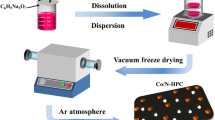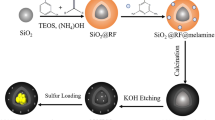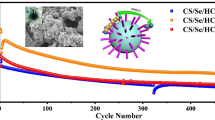Abstract
Lithium–sulfur batteries possess high specific capacity and low raw material costs, are considered to be a candidate for replacing traditional lithium-ion batteries. However, the shuttle effect of polysulfide and the low conductivity of sulfur seriously hinder the practical application of lithium–sulfur batteries. Herein, we proposed a hollow porous carbon sphere (HCS) doped with Co(OH)2 as the cathode of lithium–sulfur battery to suppress the shuttle effect. The hollow carbon sphere structure not only restricts the migration of polysulfide, but also improves the overall conductivity of the material, and provides a larger cavity to buffer the expansion of battery during the charging and discharging process. The lithium–sulfur battery using Co(OH)2/HCS composite electrode as cathode delivers initial specific capacity of 865 mAh g−1 at 0.2 C and retains high capacity of 641 mAh g−1 after 400 cycles at 0.2 C with low fading rate(FR) of 0.134% per cycle.








Similar content being viewed by others
Data Availability
The data that support the findings of this study are available on request from the corresponding author, Hu, upon reasonable request.
References
Hao W, Jing G, Hong-Tao G, Zi-Yang G, Yong-Gang W, Geng-Feng Z et al (2016) Egg-Derived Mesoporous Carbon Microspheres as Bifunctional Oxygen Evolution and Oxygen Reduction Electrocatalysts. Adv Energy Mater 6:0794
Evan ME, Chandan G, Doron A (2014) New Horizons for Conventional Lithium Ion Battery Technology. J Phys Chem Lett 5:3313
Chaohe X, Binghui X, Yi G, Zhigang X, Jing SXSZ (2013) Graphene-based electrodes for electrochemical energy storage. Energy & Environmental Science Energy. Environ Sci 6:1388
Yu L, Jiawei Z, Qingguo C, Xinhui X, Minghua C (2021) Emerging of Heterostructure Materials in Energy Storage: A Review. Advanced Materials Adv Mater 33:0855
Chaohe X, Binghui X, Yi G, Zhigang X, Jing S, XSZ, et al (2018) Status and challenges in enabling the lithium metal electrode for high-energy and low-cost rechargeable batteries. Nat Energy 3:16
Pan Z, Cheng L, Xiaofeng Z, Cheng Y, Yungui C, Haiping L et al (2020) Enhanced Catalytic Conversion of Polysulfides Using Bimetallic Co(7)Fe(3) for High-Performance Lithium-Sulfur Batteries. ACS Nano 14:11558
Zhaohuan W, Ren Yaqi, Joshua S, Zhu Xiaodong, Gang W (2020) Mechanistic understanding of the role separators playing in advanced lithium-sulfur batteries. Infomat 2:483
Jiangyun Z, Dan S, Liqin J, Guoqing Z, Hongwei W, Rodney D et al (2022) Advanced thermal management system driven by phase change materials for power lithium-ion batteries: A review. Renewable Sustainable Energy Rev 159
Jian Z, Jianli Z, Hua C, Yingying G, Zhouguang L (2019) High energy batteries based on sulfur cathode. Green Energy Environ 4:345
Xiaojing F, Wenwei S, Fancheng M, Aiming X, Jiehua L (2018) Advanced chemical strategies for lithium-sulfur batteries: A review. Green Energy Environ 3:2
Yuankun W, Ruifang Z, Yuanchao P, Xu C, Jinxin L, Jiangjing X et al (2019) Carbon@titanium nitride dual shell nanospheres as multi-functional hosts for lithium sulfur batteries. Energy Stor Mater 16:228
Donghai L, Chen Z, Guangmin Z, Wei L, Guowei L, Linjie Z et al (2018) Catalytic Effects in Lithium-Sulfur Batteries: Promoted Sulfur Transformation and Reduced Shuttle. Effect Adv Sci 5:1700270
Hai H, Lifeng C, Weikang G, Zhiyuan Z, Shifei K (2023) Unraveling the hierarchical porous structure in natural pollen-derived Fe-containing carbon to address the shuttle effect and dead sulfur problems in lithium-sulfur batteries. Chem Eng J 453
Yun-Xiao W, Wei-Hong L, Yun-Xia W, Shu-Lei C, Xinping A, Hanxi Y et al (2019) Sulfur-Based Electrodes that Function via Multielectron Reactions for Room-Temperature Sodium-Ion Storage. Angew Chem Int Ed 58:18324
Zhen L, Haobin W, Xiongwen L (2016) Rational designs and engineering of hollow micro-/nanostructures as sulfur hosts for advanced lithium-sulfur batteries. Energy. Environ Sci 9:3061
Al-Dahawi A, Ozturk O, Emami F, Yildlrim G, Sahmaran M (2016) Effect of mixing methods on the electrical properties of cementitious composites incorporating different carbon-based materials [J]. Construction and Building Materials. Constr Build Mater 104:160
Lin Z, Liu Z, Fu W, Dudney NJ, Liang C (2013) Lithium polysulfidophosphates: a family of lithium-conducting sulfur-rich compounds for lithium-sulfur batteries. Angew Chem Int Ed 52:7460
Jiaojiao L, Zhen X, Anqi C, Wenkui Z, Dongmin Z, Yanxian J et al (2020) Functionally Modified Polyolefin-Based Separators for Lithium-Sulfur Batteries: Progress and Prospects. Front Energy Res 8:593640
Linlin Z, Yijing W, Zhiqiang N, Jun C (2019) Advanced nanostructured carbon-based materials for rechargeable lithium-sulfur batteries. Carbon 141:400
Shi C, Hamann T, Takeuchi S, Alexander GV, Nolan AM, Limpert M et al (2023) 3D Asymmetric Bilayer Garnet-Hybridized High-Energy-Density Lithium−Sulfur Batteries. ACS Appl. Mater Interfaces 15
Shi C, Takeuchi S, Alexander GV, Hamann T, O’Neill J, Dura JA et al (2023) High Sulfur Loading and Capacity Retention in Bilayer Garnet Sulfurized-Polyacrylonitrile/Lithium-Metal Batteries with Gel Polymer Electrolytes. Adv Energy Mater 13:2301656
Seung-Keun P, Jung-Kul L, Yun Chan K (2018) Yolk-Shell Structured Assembly of Bamboo-Like Nitrogen-Doped Carbon Nanotubes Embedded with Co Nanocrystals and Their Application as Cathode Material for Li-S Batteries [J]. Advanced Functional Materials. Adv Funct Mater 28:1705264
Zhian Z, Guanchao W, Yanqing L, Jie L, Zhiyong Z, Wei C (2015) Nitrogen-doped porous hollow carbon sphere-decorated separators for advanced lithium–sulfur batteries. J Power Sources 300:157
Bai S, Sun Y, Yi J, He Y, Qiao Y, Zhou H (2018) High-Power Li-Metal Anode Enabled by Metal-Organic Framework Modified Electrolyte. Joule 2:2117
Jiangxuan S, Mikhail LG, Terrence X, Shuru C, Zhaoxin Y, Hiesang S et al (2015) Strong lithium polysulfide chemisorption on electroactive sites of nitrogen-doped carbon composites for high-performance lithium-sulfur battery cathodes. Angew Chem Int Ed 54:4325
Minggao Z, Hui L, Yanqi F, Junqi L, Xuanmeng H, Xin T et al (2022) 3D hollow reduced graphene oxide coated TiO2 heterostructures as an advanced host-interlayer integrated electrode for enhanced Li-S batteries. Solid State Ion 381
Xuliang F, Ruobing C, Yu L, Fang C, Liwei L, Bihui Y et al (2022) Oxygen-defective MnO2 decorated carbon nanotube as an effective sulfur host for high performance lithium sulfur battery [J]. Advanced Powder Technology. Adv Powder Technol 33
Tianye M, Mengmeng L, Tao H, Aishui Y (2018) Al2O3 -doped ZnO coating of carbon nanotubes as cathode material for lithium-sulfur batteries. J Power Sources 398:75
Seung Jae Y, Seunghoon N, Taehoon K, Ji Hyuk I, Haesol J, Jong Hun K et al (2013) Preparation and Exceptional Lithium Anodic Performance of Porous Carbon-Coated ZnO Quantum Dots Derived from a Metal-Organic Framework. J Am Chem Soc 135:7394
Tao X, Wang J, Liu C, Wang H, Yao H, Zheng G et al (2016) Balancing surface adsorption and diffusion of lithium-polysulfides on nonconductive oxides for lithium-sulfur battery design. Nat Commun 7:11203
Long J, Joanne Yen RuS, William Scott S, Zhiyong UW, Hai-Long J (2019) Metal–organic frameworks: Structures and functional applications. Materials Today Mater. Today 27:43
Liang Z, Qu C, Guo W, Zou R, Xu Q (2018) Pristine Metal-Organic Frameworks and their Composites for Energy Storage and Conversion. Adv Mater 30:1702891
Song G, Shi Y, Jiang S, Pang H (2023) Recent Progress in MOF-Derived Porous Materials as Electrodes for High-Performance Lithium-Ion Batteries. Adv Funct Mater 33:2303121
Jintao Z, Han H, Zhen L, Xiong Wen L (2016) Double-Shelled Nanocages with Cobalt Hydroxide Inner Shell and Layered Double Hydroxides Outer Shell as High-Efficiency Polysulfide Mediator for Lithium-Sulfur Batteries. Angew Chem Int Ed 55:3982
Pan L, Wenting Y, Fangyuan X, Yuruo Q, Sidra J et al (2021) Efficient Anchoring of Polysulfides Based on Self-Assembled Ti3C2Tx Nanosheet-Connected Hollow Co(OH)2 Nanotubes for Lithium–Sulfur BatteriesACS. Appl Mater Interfaces 13:57285
Xiao-qing N, Xiu-li W, Dong-huang W, Yi L, Yi-jun Z, Yi-di Z et al (2015) Metal hydroxide – a new stabilizer for the construction of sulfur/carbon composites as high-performance cathode materials for lithium–sulfur batteries. J Mater Chem A 3:17106
Jinguo Z (2019) Ni(OH)2@hollow carbon spheres/sulfur composites as cathode materials for high-performance Li–S batteries. J Mater Sci Mater Electron 30:17155
Dian-Dian H, Sheng L, Ya-Tao L, Ze Z, Guoran L, Xueping G (2018) Lithiophilic gel polymer electrolyte to stabilize the lithium anode for a quasi-solid-state lithium–sulfur battery. J Mater Chem A 6:18627
Shencheng P, Juan Y, Yongxing Z, Bing L (2020) Facile and novel strategy to fabricate 2D α-Co(OH)2 nanosheets for efficient oxygen evolution reaction application. Mater Lett 278
Zuozhong L, Chaochao Z, Yang X, Wei Z, Haoquan Z, Rui C (2019) Dual Tuning of Ultrathin α-Co(OH)2 Nanosheets by Solvent Engineering and Coordination Competition for Efficient Oxygen Evolution. ACS Sustain Chem Eng 7:3527
Hidayat Ullah S, Fengping W, Muhammad Sufyan J, MA A, Muhammad S, Jinbing Z et al (2018) In-situ growth of MnO2 nanorods forest on carbon textile as efficient electrode material for supercapacitors. J Energy Storage 17:318
Jun S, Nan L, Hai-bo L, Jin Y, Wen-li Z (2020) A N-doped rice husk-based porous carbon as an electrocatalyst for the oxygen reduction reaction. New Carbon Mater 35:401
Khater HM, Abd el Gawaad HA (2016) Characterization of alkali activated geopolymer mortar doped with MWCNT. Constr Build Mater 102:329
Lei Z, Dmitri LD, Rüdiger-AE Peter HLN (2020) Host Materials Anchoring Polysulfides in Li–S Batteries Reviewed. Adv Energy Mater 11:2001304
Zhou G, Tian H, Jin Y, Tao X, Cui Y (2017) Catalytic oxidation of Li2S on the surface of metal sulfides for Li-S batteries. Proc Natl Acad Sci USA 114:840
Jiangyu H, Wenpo L, Xiuli Z, Dongdong Z, Xinyue L, Yujie Q et al (2018) Phosphate ion functionalization of Co(OH)2 nanosheets by a simple immersion method. J Alloys Compd 768:57
Xiaoping L, Zhenghui P, Zihao L, Yaotang Z, Xianshu W, Mengqing X et al (2018) Functionalized N-doped hollow carbon spheres as sulfur host with enhanced electrochemical performances of lithium-sulfur batteries. Ionics 25:503
Qihua L, Jian Y, Yue Z, Zengcheng Z, Chao W, Hao H et al (2020) Synergistic effect of cobalt, nitrogen-codoped hollow carbon sphere hosts for high performance lithium sulfur batteries. New J Chem 44:5965
Tao P, Ning Z, Ya Y, Mengjie Z, Rongjie L, Chen C et al (2022) Crystal Facet Engineering of MXene-Derived TiN Nanoflakes as Efficient Bidirectional Electrocatalyst for Advanced Lithium-Sulfur Batteries. Small 18:2202917
Boyu L, Qingmei S, Lintao Y, Jun Z, Gaohui D, Dong W et al (2020) Tuning the Band Structure of MoS2 via Co9S8@MoS2 Core-Shell Structure to Boost Catalytic Activity for Lithium-Sulfur Batteries. ACS Nano 14:17285
Jing Z, Xiulin F, Guangbin J, Haiyang W, Singyuk H, Demella KC et al (2018) Manipulating electrolyte and solid electrolyte interphase to enable safe and efficient Li-S batteries. Nano Energy 50:431
Jiongwei S, Wei W, Bing Z, Xinying W, Weiliang Z, Liguo Y et al (2022) Unraveling the Atomic‐Level Manipulation Mechanism of Li2S Redox Kinetics via Electron‐Donor Doping for Designing High‐Volumetric‐Energy‐Density, Lean‐Electrolyte Lithium–Sulfur Batteries. Adv Sci 9:2204192
Michael EGL, Michael PB (2009) The significance of electrochemical impedance spectra recorded during active oxygen evolution for oxide covered Ni, Co and Fe electrodes in alkaline solution. J Electroanal Chem 631:62
Lopes T, Andrade L, Ribeiro HA, Mendes A (2010) Characterization of photoelectrochemical cells for water splitting by electrochemical impedance spectroscopy. Int J Hydrog Energy 35:11601
Xueyuan W, Xuezhe W, Haifeng D (2019) Estimation of state of health of lithium-ion batteries based on charge transfer resistance considering different temperature and state of charge. J Energy Storage 21:618
Pan L, Wengting Y, Fangyuan X, Yuruo Q, Sidra J, Maowen X (2121) Efficient Anchoring of Polysulfides Based on Self-Assembled Ti3C2Tx Nanosheet-Connected Hollow Co(OH)2 Nanotubes for Lithium− Sulfur Batteries. ACS Appl Mater Interfaces 13:57285
Longlong R, Linhui W, Yufeng Q, Qiang L (2022) High Cycle Stability of Hybridized Co(OH)2 Nanomaterial Structures Synthesized by the Water Bath Method as Anodes for Lithium-Ion Batteries. Micromachines 13:149
Yonghuan F, Liewu L, Shenghua Y, Penggang Y, Peng L, Xiongzhong R et al (2021) Construction of cobalt oxyhydroxide nanosheets with rich oxygen vacancies as high-performance lithium-ion battery anodes. J Mater Chem A 9:453–462
Wanlu Y, Zan G, Jing M, Jun W, Xingming Z, Lianhe L (2011) Two-step electrodeposition construction of flower-onsheet hierarchical cobalt hydroxide nano-forest for high-capacitance supercapacitors. Dalton Trans 42:15706
Peng G, Ying Z, Pei T, Zixing W, Jiaofeng Y, Aiping H (2021) Adv Funct Mater 32:2108644
Park Joon Yong, Kin Ha Young, Kim Yong-ll, Jo So Yeong, Abbas Syed Asad, Seo Dongho et al (2022) Correction: Chemical and electrochemical synthesis of cobalt hydroxides: selective phase transformation and application to distinct electrocatalytic reaction. J Mater Chem A 10:12047
Jinglong H, Jian S, Donghui L, Qinghua T (2023) Ultrathin CoOOH/Co(OH)2 hybrid nanosheets for high-performance anodes of lithium-ion batteries. J Alloys Compd 935:168076
Funding
This work was financially supported by the National Natural Science Foundation of China (Grant No. 11727902 and No. 12175098), and this research was supported by Jiangxi Provincial Innovation Talents of Science and Technology (20165BCB18003).
Author information
Authors and Affiliations
Contributions
Xianxin Lai wrote the main manuscript text and completed the experiment; Kaibo Fan provided suggestions for the experiment; Zhiqi Zhang, Lili Cai, Zhongheng Zhu, Haozhong Huang and Qichen Zhang assisted the experiment; Ling Sun provided the experimental materials; Zhehui Zhou operated SEM; Liwang provided funding; Zhengguang hu provided suggestions for the experiment and revised the paper; Yong Zhao provided funding and provided suggestions for the experiment; All authors reviewed the manuscript.
Corresponding authors
Ethics declarations
Competing interests
The authors declare no competing interests.
Additional information
Publisher's Note
Springer Nature remains neutral with regard to jurisdictional claims in published maps and institutional affiliations.
Rights and permissions
Springer Nature or its licensor (e.g. a society or other partner) holds exclusive rights to this article under a publishing agreement with the author(s) or other rightsholder(s); author self-archiving of the accepted manuscript version of this article is solely governed by the terms of such publishing agreement and applicable law.
About this article
Cite this article
Lai, X., Fan, K., Zhang, Z. et al. Cobalt hydroxide decorating N-doped hollow carbon sphere as a new sulfur host to improve long cycle stability in lithium–sulfur batteries. Ionics 30, 2029–2038 (2024). https://doi.org/10.1007/s11581-024-05390-y
Received:
Revised:
Accepted:
Published:
Issue Date:
DOI: https://doi.org/10.1007/s11581-024-05390-y




